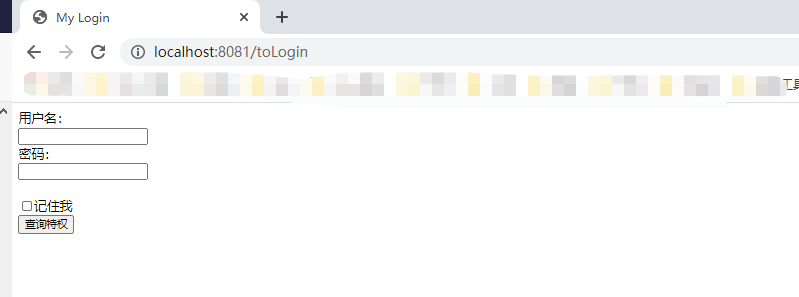本文主要介绍SpringBoot:集成SpringSecurity
- SpringSecurity官方介绍
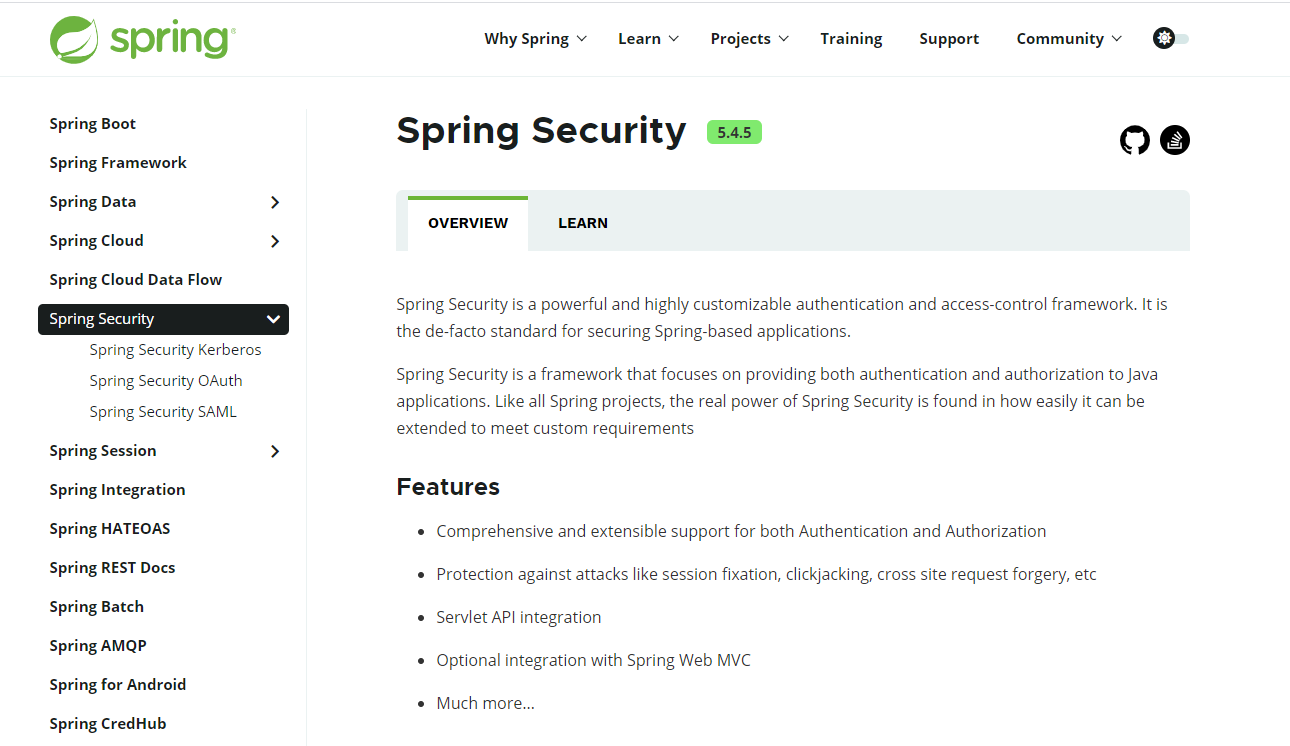
Spring Security是一个功能强大且高度可定制的身份验证和访问控制框架。它实际上是保护基于spring的应用程序的标准。
Spring Security是一个框架,侧重于为Java应用程序提供身份验证和授权。与所有Spring项目一样,Spring安全性的真正强大之处在于它可以轻松地扩展以满足定制需求。
一般来说,Web 应用的安全性包括用户认证(Authentication)和用户授权(Authorization)两个部分。
-
用户认证:指的是验证某个用户是否为系统中的合法主体
也就是说用户能否访问该系统,用户认证一般要求用户提供用户名和密码。系统通过校验用户名和密码来完成认证过程。 -
用户授权:指的是验证某个用户是否有权限执行某个操作
在一个系统中,不同用户所具有的权限是不同的。比如对一个文件来说,有的用户只能进行读取,而有的用户可以进行修改。一般来说,系统会为不同的用户分配不同的角色,而每个角色则对应一系列的权限。
对于上面提到的两种应用情景,Spring Security 框架都有很好的支持。在用户认证方面,Spring Security 框架支持主流的认证方式,包括 HTTP 基本认证、HTTP 表单验证、HTTP 摘要认证、OpenID 和 LDAP 等。在用户授权方面,Spring Security 提供了基于角色的访问控制和访问控制列表(Access Control List,ACL),可以对应用中的领域对象进行细粒度的控制。
- SpringSecurity基本原理(图片来自百度搜索)
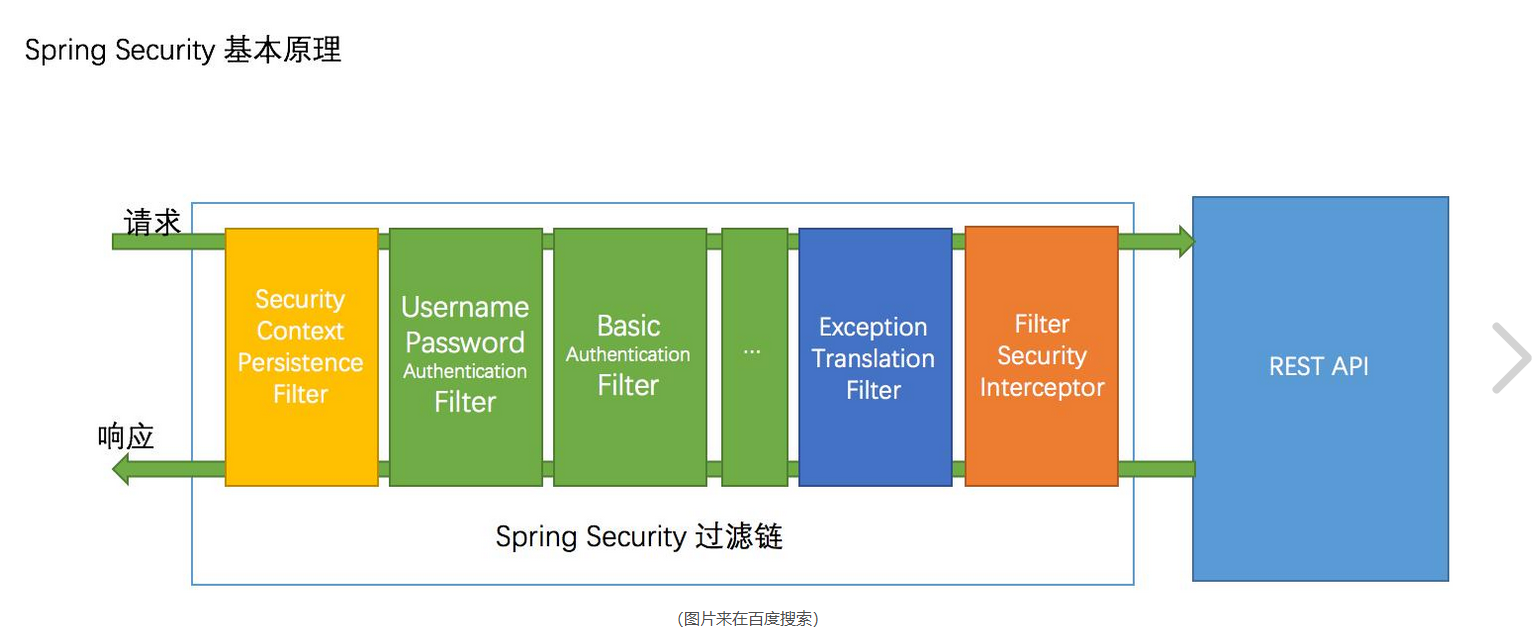
- 入门实战:
1.介绍项目内容
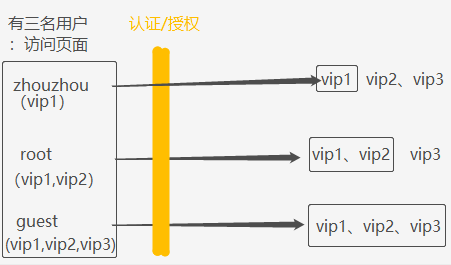
2.新建SpringBoot项目:springboot-security,引入thymeleaf引擎

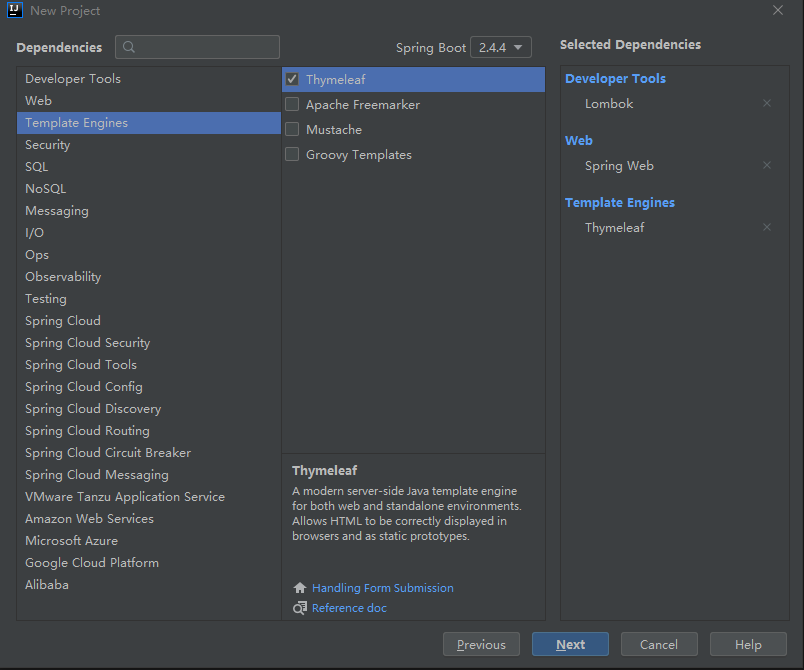
3.编写静态资源
(在 templates 下创建,结构如下:)
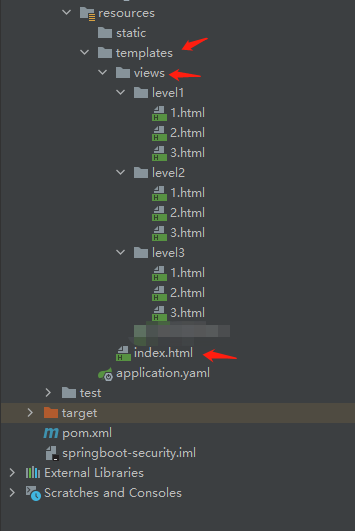
注:index.html 文件,在下方会有代码演示,可以拼凑成完整的
4.编写controller
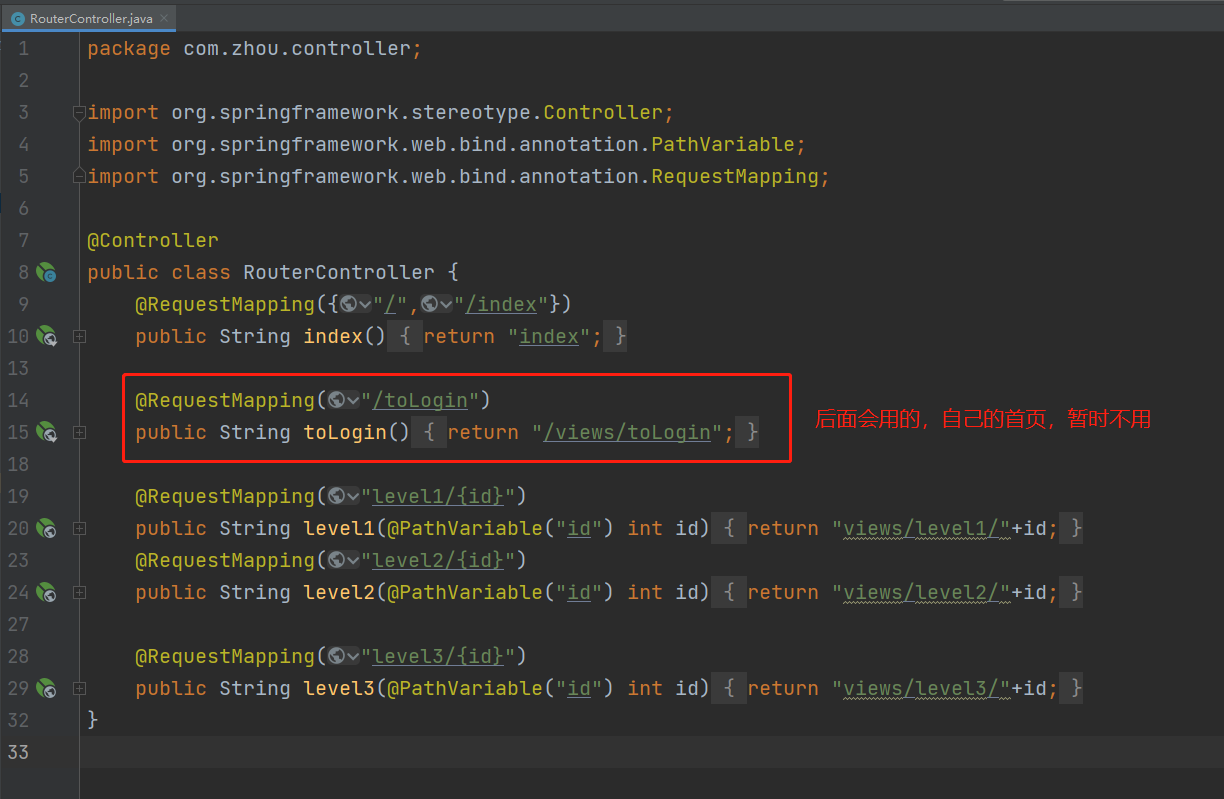
package com.zhou.controller;
import org.springframework.stereotype.Controller;
import org.springframework.web.bind.annotation.PathVariable;
import org.springframework.web.bind.annotation.RequestMapping;
@Controller
public class RouterController {
@RequestMapping({"/","/index"})
public String index(){
return "index";
}
@RequestMapping("/toLogin")
public String toLogin(){
return "/views/toLogin";
}
@RequestMapping("level1/{id}")
public String level1(@PathVariable("id") int id){
return "views/level1/"+id;
}
@RequestMapping("level2/{id}")
public String level2(@PathVariable("id") int id){
return "views/level2/"+id;
}
@RequestMapping("level3/{id}")
public String level3(@PathVariable("id") int id){
return "views/level3/"+id;
}
}
5.运行一下,测试环境是否OK!
- SpringSecurity 认证和授权
目前,上面的测试环境,是谁都可以访问的,我们使用 Spring Security 增加上认证和授权的功能。
1.引入 Spring Security 模块

<dependency>
<groupId>org.springframework.boot</groupId>
<artifactId>spring-boot-starter-security</artifactId>
</dependency>
2.观察 Spring Security 配置类
探索一下 WebSecurityConfiguration 类的源码:

发现其拥有一个过滤功能的方法 springSecurityFilterChain()
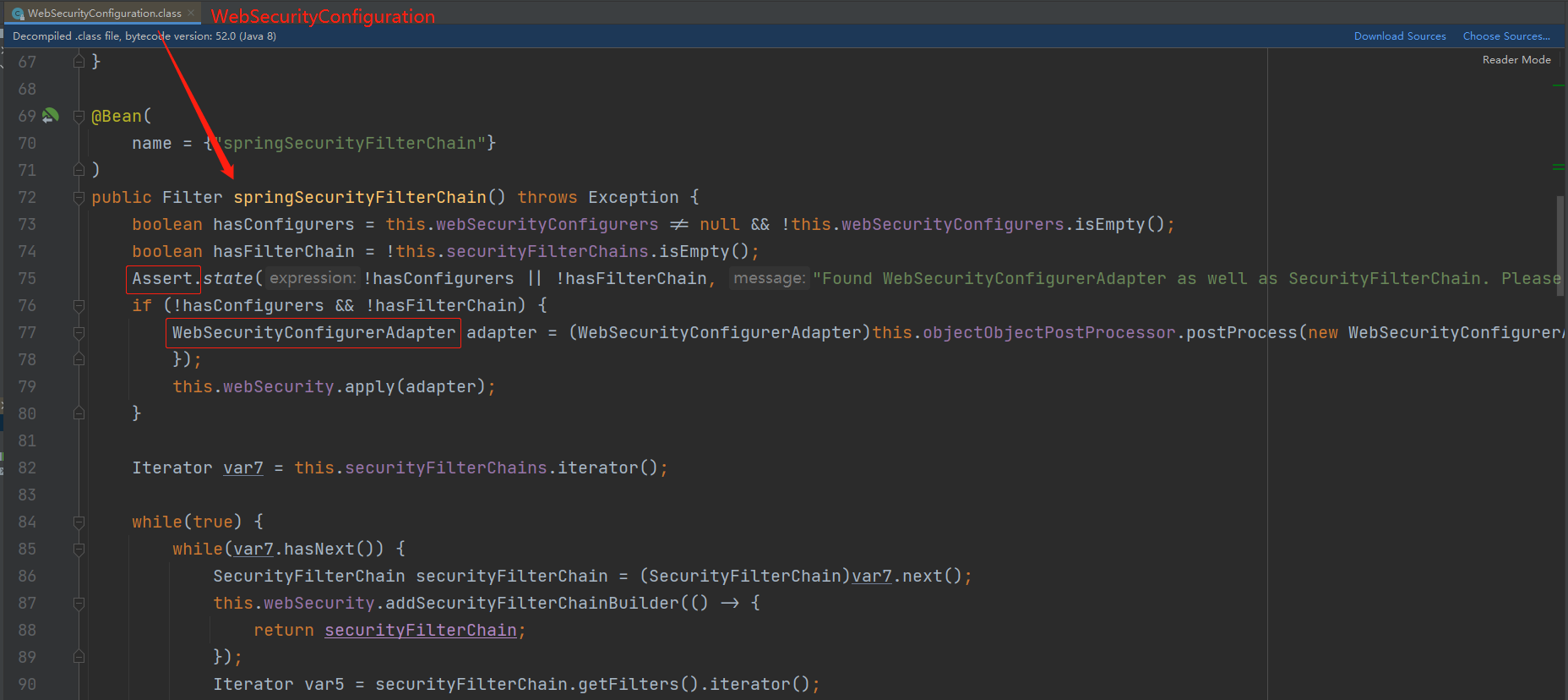
WebSecurityConfigurerAdapter 做了哪些事情
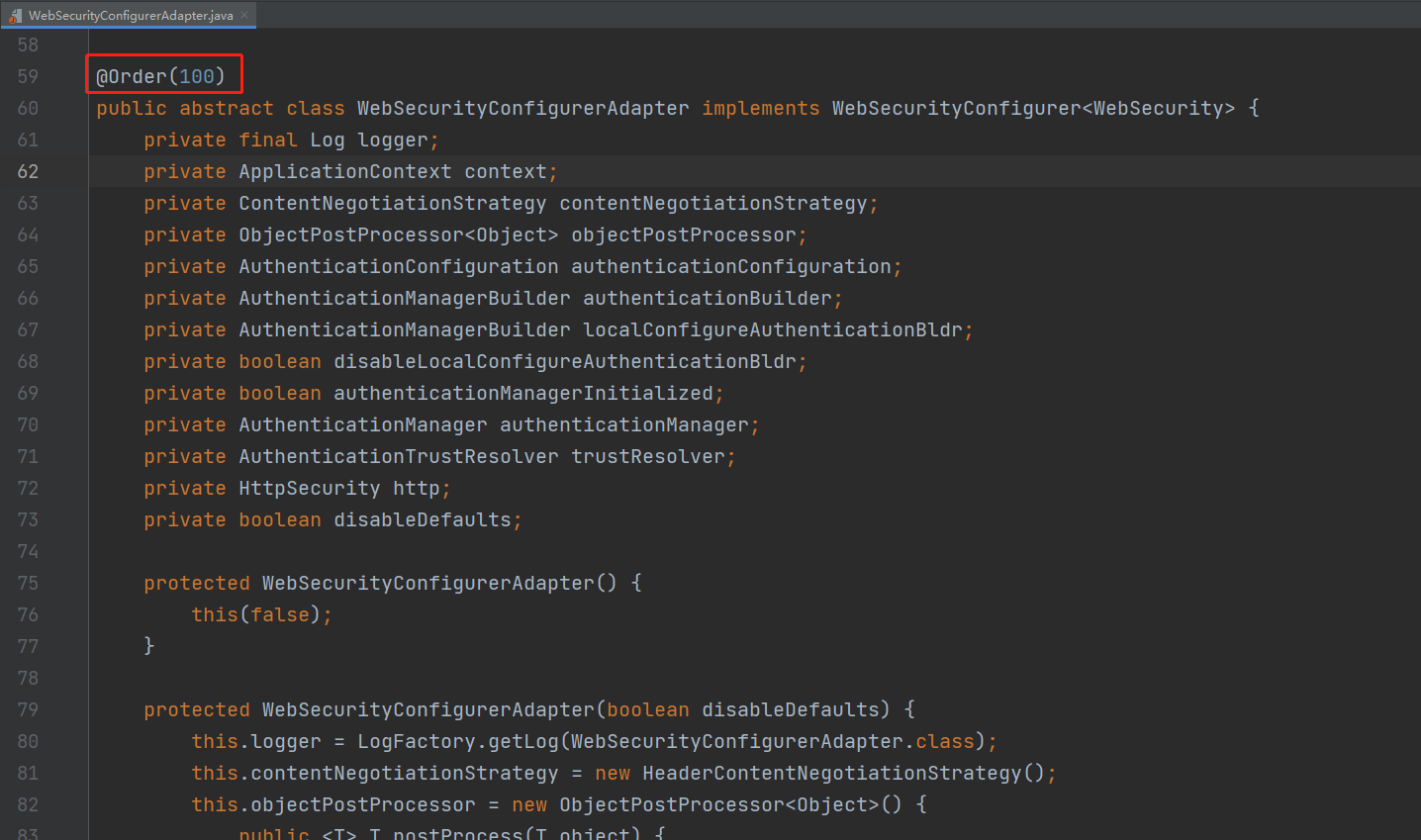
参考官网:https://docs.spring.io/spring-security/site/docs/5.4.5/reference/html5/
比如,官方文档提到的在验证Username and Password时,采用一下做法:
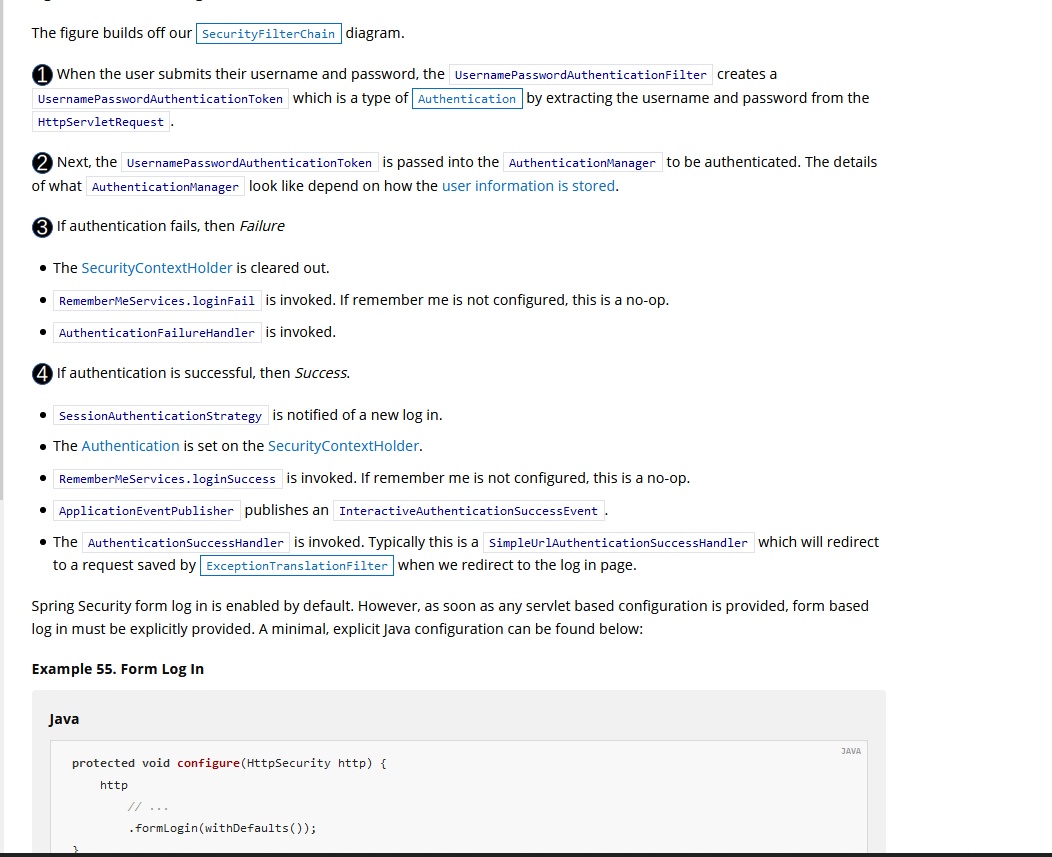
3.开始编写配置类:SecurityConfig

import org.springframework.security.config.annotation.web.builders.HttpSecurity;
import org.springframework.security.config.annotation.web.configuration.EnableWebSecurity;
import org.springframework.security.config.annotation.web.configuration.WebSecurityConfigurerAdapter;
@EnableWebSecurity
public class SecurityConfig extends WebSecurityConfigurerAdapter {
@Override
protected void configure(HttpSecurity http) throws Exception {
}
}
4.定制(请求的)授权规则
@Override
protected void configure(HttpSecurity http) throws Exception {
// 定制请求的授权规则
// 首页所有人可以访问
http.authorizeRequests().antMatchers("/").permitAll()
.antMatchers("/level1/**").hasRole("vip1")
.antMatchers("/level2/**").hasRole("vip2")
.antMatchers("/level3/**").hasRole("vip3");
}
5.Run 测试:http://localhost:8081
发现只有首页能进去,访问其他页面,控制台输出:
org.thymeleaf.exceptions.TemplateInputException: Error resolving template [/login], template might not exist or might not be accessible by any of the configured Template Resolvers
原因:目前没有登录的角色,因为请求需要登录的角色拥有对应的权限才可以。
解决:在configure()方法中开启自动配置的登录功能:
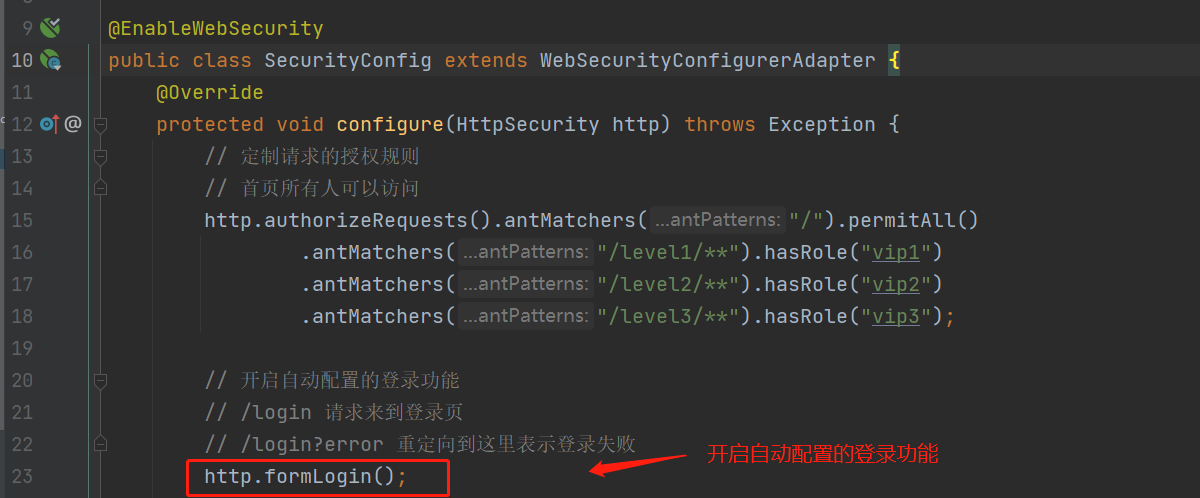
http.formLogin();
6.继续访问:http://localhost:8081/login 弹出页面
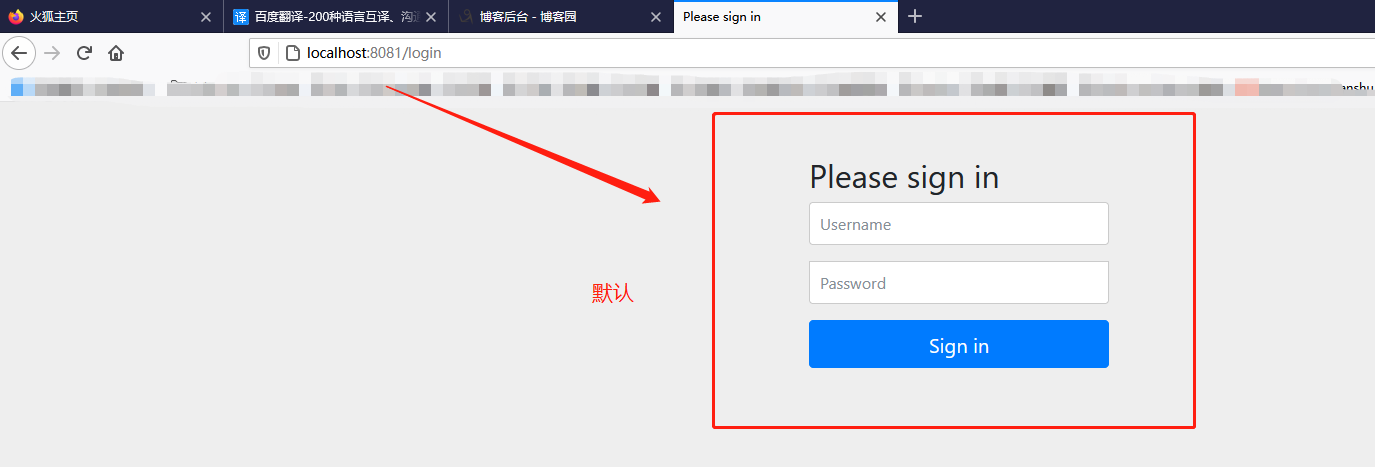
并且,重定向到 http://localhost:8081/login?error 表示登录失败

7.定义认证规则:重写 configure(AuthenticationManagerBuilder auth)方法
//定义认证规则
@Override
protected void configure(AuthenticationManagerBuilder auth) throws Exception {
//在内存中定义,也可以在jdbc中去拿.
auth.inMemoryAuthentication().passwordEncoder(new BCryptPasswordEncoder())
.withUser("zhouzhou").password"123").roles("vip2")
.and()
.withUser("root").password("123").roles("vip1", "vip2")
.and()
.withUser("guest").password("123").roles("vip1", "vip2","vip3");
}
8.Run 测试,登录用户名和密码
报错:
java.lang.IllegalArgumentException: There is no PasswordEncoder mapped for the id "null"

原因:要将前端传过来的密码进行某种方式加密,否则就无法登录,修改代码。
解决:spring security 官方推荐的是使用bcrypt加密方式
//定义认证规则
@Override
protected void configure(AuthenticationManagerBuilder auth) throws Exception {
//在内存中定义,也可以在jdbc中去拿.
//Spring security 5.0中新增了多种加密方式,也改变了密码的格式。
//要想我们的项目还能够正常登陆,需要修改一下configure中的代码。我们要将前端传过来的密码进行某种方式加密
auth.inMemoryAuthentication().passwordEncoder(new BCryptPasswordEncoder())
.withUser("zhouzhou").password(new BCryptPasswordEncoder().encode("123")).roles("vip2")
.and()
.withUser("root").password(new BCryptPasswordEncoder().encode("123")).roles("vip1", "vip2")
.and()
.withUser("guest").password(new BCryptPasswordEncoder().encode("123")).roles("vip1", "vip2","vip3");
}
- Run 测试,登录成功,并且每个角色只能访问自己认证下的规则
- 权限控制和注销
1.开启自动配置的注销的功能
//定制请求的授权规则
@Override
protected void configure(HttpSecurity http) throws Exception {
//省略上面重复代码
//开启自动配置的注销的功能:logout 注销请求
http.logout();
}
2.在前端(index.html),增加一个注销的按钮
<!--前端开启注销功能-->
<div sec:authorize="isAuthenticated()">
<a class="item" th:href="@{/logout}">注销</a>
</div>
3.Run 测试,登录成功后点击注销(发现注销完毕会跳转到登录页面)
4.设置注销成功后,依旧可以跳转到首页
// .logoutSuccessUrl("/"); 注销成功来到首页
http.logout().logoutSuccessUrl("/");
5.Run 测试跳转成功了
此时,虽然做到了认证和授权,但是页面显示需要优化,比如,下面的问题:
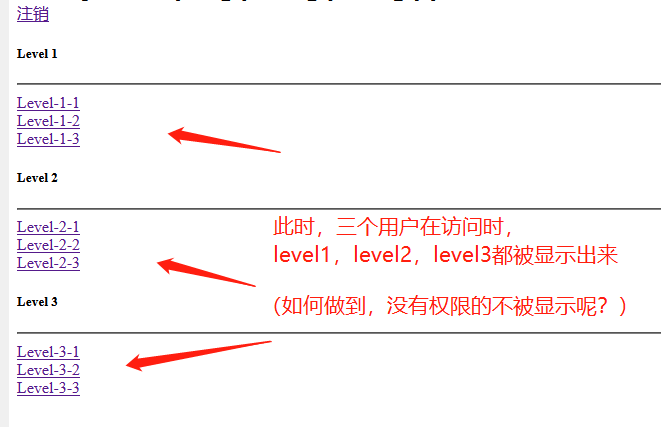
注:利用 thymeleaf 中的 sec:authorize="isAuthenticated()"和sec:authorize="hasRole('')",完成认证功能
1.导入依赖
<!-- https://mvnrepository.com/artifact/org.thymeleaf.extras/thymeleaf-extras-springsecurity4 -->
<dependency>
<groupId>org.thymeleaf.extras</groupId>
<artifactId>thymeleaf-extras-springsecurity5</artifactId>
<version>3.0.4.RELEASE</version>
</dependency>
2.修改前端页面
a.导入命名空间
xmlns:sec="http://www.thymeleaf.org/thymeleaf-extras-springsecurity5"
b.修改 登录和注销(增加认证判断)
<!--登录注销-->
<div class="right menu">
<!--如果未登录-->
<div sec:authorize="!isAuthenticated()">
<a class="item" th:href="@{/login}">登录</a>
</div>
<!--如果已登录-->
<div sec:authorize="isAuthenticated()">
<a class="item">
<i class="address card icon"></i>
用户名:<span sec:authentication="principal.username"></span>
特权:<span sec:authentication="principal.authorities"></span>
</br>
</a>
</div>
<!--前端开启注销功能-->
<div sec:authorize="isAuthenticated()">
<a class="item" th:href="@{/logout}">注销</a>
</div>
</div>
3.Run 测试 达到预期效果
【注意】如果注销404了,是因为它默认防止csrf跨站请求伪造,因为会产生安全问题,我们可以将请求改为post表单提交。
或者在spring security 中关闭csrf功能,如下配置中增加:
//关闭csrf功能:跨站请求伪造,默认只能通过post方式提交logout请求
http.csrf().disable();
4.修改 用户和权限(增加认证判断)
<!-- sec:authorize="hasRole('vip1')" -->
<div sec:authorize="hasRole('vip1')">
<div>
<h5 class="content">Level 1</h5>
<hr>
<div><a th:href="@{/level1/1}"><i class="bullhorn icon"></i> Level-1-1</a></div>
<div><a th:href="@{/level1/2}"><i class="bullhorn icon"></i> Level-1-2</a></div>
<div><a th:href="@{/level1/3}"><i class="bullhorn icon"></i> Level-1-3</a></div>
</div>
</div>
<div sec:authorize="hasRole('vip2')">
<div>
<h5 class="content">Level 2</h5>
<hr>
<div><a th:href="@{/level2/1}"><i class="bullhorn icon"></i> Level-2-1</a></div>
<div><a th:href="@{/level2/2}"><i class="bullhorn icon"></i> Level-2-2</a></div>
<div><a th:href="@{/level2/3}"><i class="bullhorn icon"></i> Level-2-3</a></div>
</div>
</div>
<div sec:authorize="hasRole('vip3')">
<div>
<h5 class="content">Level 3</h5>
<hr>
<div><a th:href="@{/level3/1}"><i class="bullhorn icon"></i> Level-3-1</a></div>
<div><a th:href="@{/level3/2}"><i class="bullhorn icon"></i> Level-3-2</a></div>
<div><a th:href="@{/level3/3}"><i class="bullhorn icon"></i> Level-3-3</a></div>
</div>
</div>
5.Run 测试OK!权限控制和注销完成。
- 记住我 功能
此时,虽然是在登录状态,但是只要关闭浏览器(不是注销),重新访问,就会要求我们重新登录。
1.开启记住我功能
//定制请求的授权规则
@Override
protected void configure(HttpSecurity http) throws Exception {
//省略上面重复代码
//记住我
http.rememberMe();
}
2.Run 测试
发现登录页多了一个记住我功能,登录之后关闭浏览器,然后重新打开浏览器访问,发现用户依旧存在。
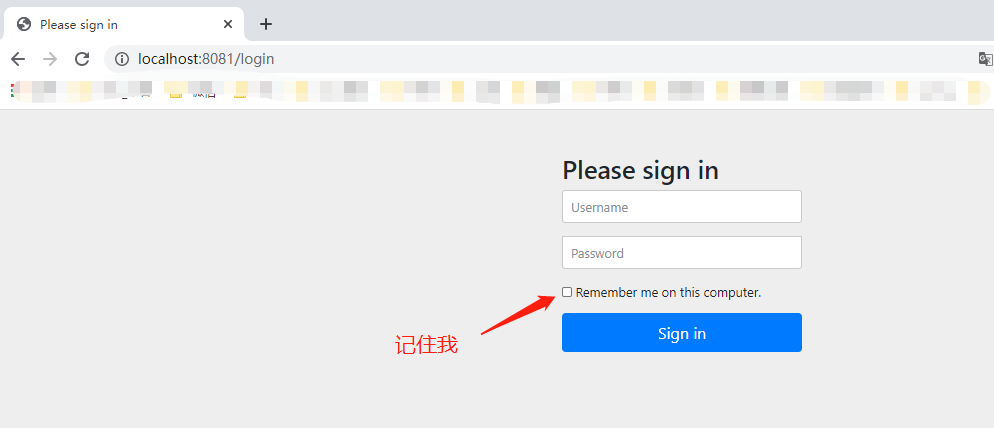
- 记住我功能如何实现的?
查看浏览器的cookie
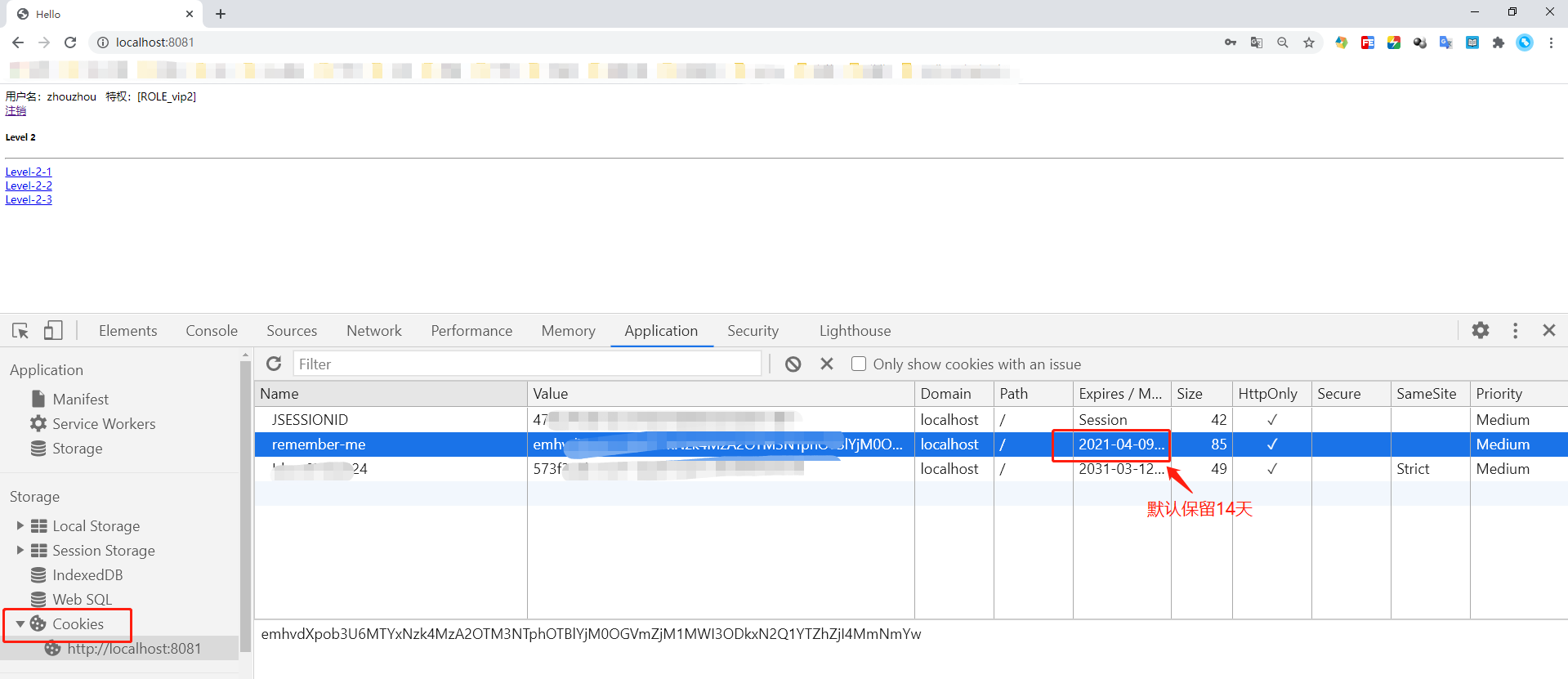
点击注销的时候,可以发现 spring security 帮我们自动删除了这个 cookie

- 定制登录页
此时,这个登录页面都是 spring security 默认的,怎么样可以使用我们自己写的Login界面呢?
1、在刚才的登录页配置后面指定 loginpage
http.formLogin().loginPage("/toLogin");
查看 FormLoginConfigurer 类的源码:(阅读注释部分)
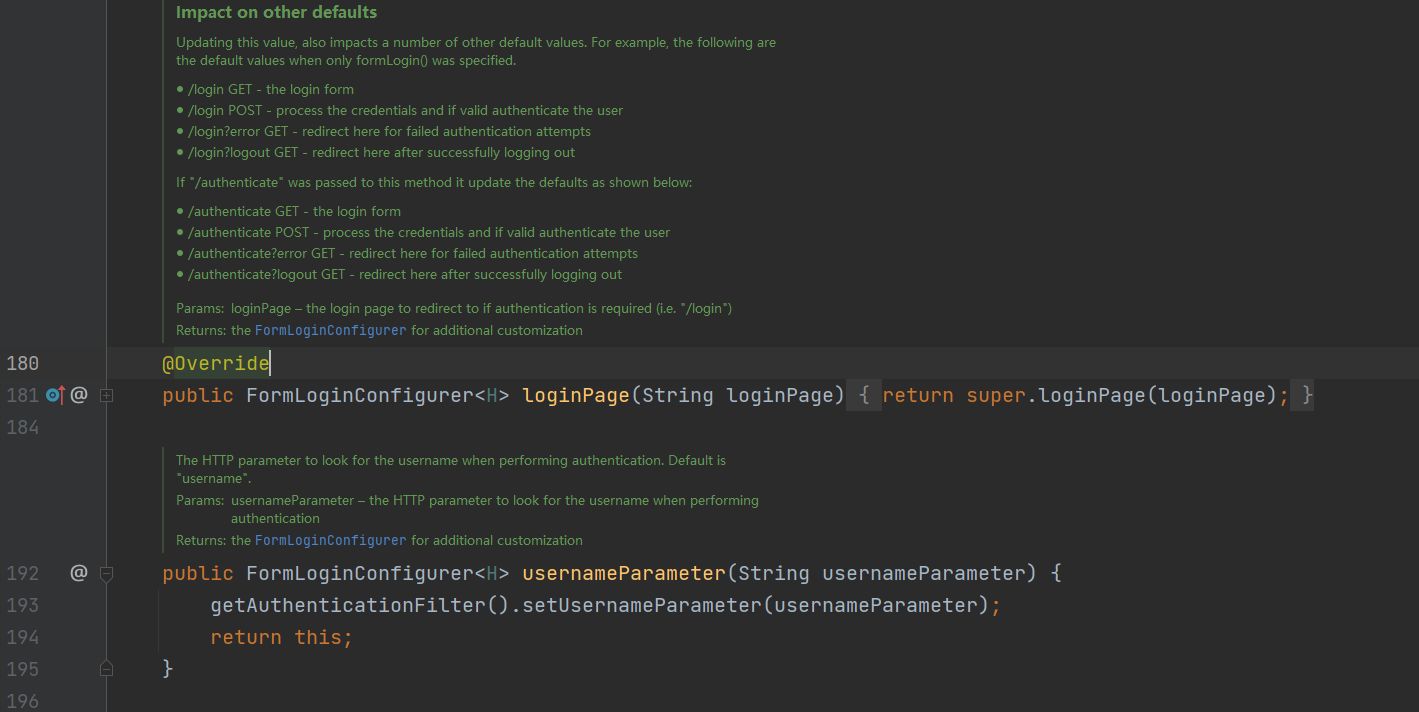
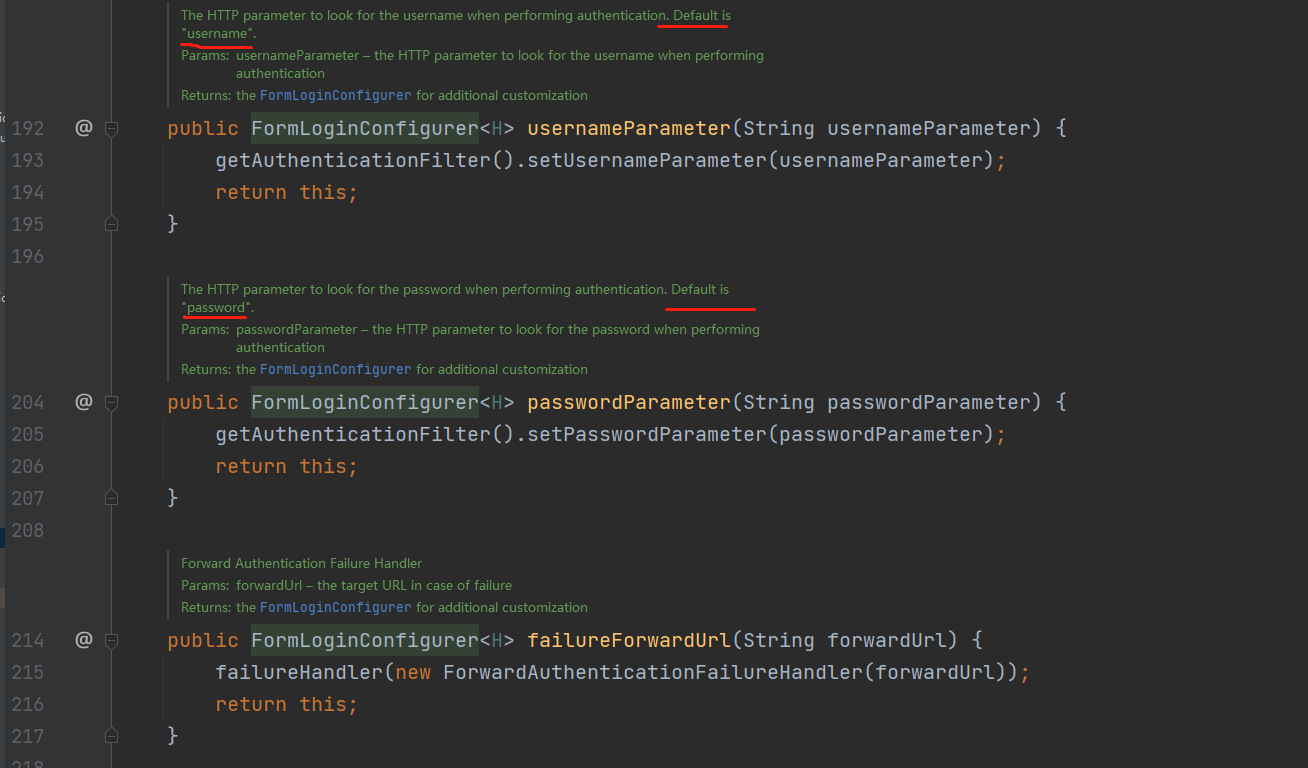
(login.html 配置提交请求及方式,方式必须为post)
2.编写一个自定义 登录页
<!DOCTYPE html>
<html lang="en" xmlns:th="http://www.thymeleaf.org">
<head>
<meta charset="UTF-8">
<title>My Login</title>
</head>
<body>
<form th:action="@{/toLogin}" method="post">
<div>
<label>用户名:</label>
<div >
<input type="text" name="username">
</div>
</div>
<div>
<label>密码:</label>
<div>
<input type="password" name="password">
</div>
</div>
<br/>
<input type="checkbox" name="remember">记住我
<br/>
<input type="submit" value="查询特权"/>
</form>
</body>
</html>
3.修改 index.html 的th:href=""
<!--登录注销-->
<div class="right menu">
<!--如果未登录-->
<div sec:authorize="!isAuthenticated()">
<a class="item" th:href="@{/toLogin}">登录</a>
</div>
<!--如果已登录-->
<div sec:authorize="isAuthenticated()">
<a class="item">
<i class="address card icon"></i>
用户名:<span sec:authentication="principal.username"></span>
特权:<span sec:authentication="principal.authorities"></span>
</br>
</a>
</div>
<!--前端开启注销功能-->
<div sec:authorize="isAuthenticated()">
<a class="item" th:href="@{/toLogin}">注销</a>
</div>
</div>
4.编写controller
@RequestMapping("/toLogin")
public String toLogin2(){
return "/views/toLogin";
}
5.提交的请求,怎样做验证处理
http.formLogin()
.usernameParameter("username")
.passwordParameter("password")
.loginPage("/toLogin")
.loginProcessingUrl("/toLogin");
http.csrf().disable();//关闭csrf功能:跨站请求伪造,默认只能通过post方式提交logout请求
http.logout().logoutSuccessUrl("/toLogin");
6.登录页,添加记住我选择框
<input type="checkbox" name="remember"> 记住我
7.后端验证处理
//定制记住我的参数!
http.rememberMe().rememberMeParameter("remember");
8.Run 测试 OK!
